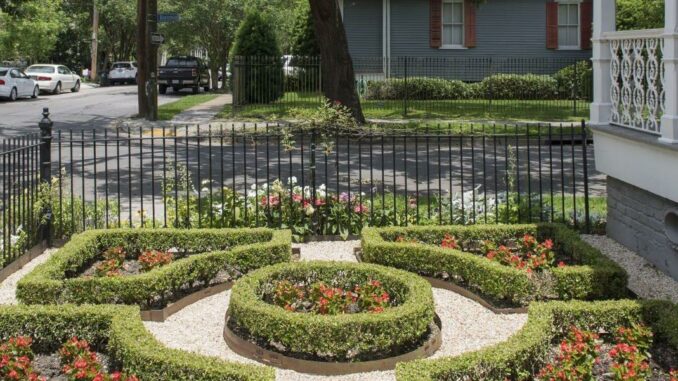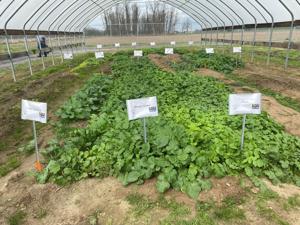
From late April through June, you may see large swarms of Formosan termites flying around lights at night. This reminds us that we must be vigilant in protecting our homes and wood structures from termites. And we should also be aware that some gardening activities may negatively impact that protection.
Houses are protected from subterranean termite damage with chemical barrier-type soil treatments. Native subterranean termites always enter a home through the soil right next to a slab, pier or attached structure. Formosan termites, introduced from Asia, generally do too, but there are some exceptions.
To protect the structure, the soil immediately next to the slab or piers is treated with a long-lasting liquid termiticide. Piers are also drilled, and the termiticide is injected into the inner void. Termiticides are also applied under the slabs of houses during construction. The treated soil next to the slab or piers is generally about 4 inches wide and about 6 inches deep. The presence of this chemical in the soil forms a protective shield that prevents termites from tunneling through the soil and entering the structure.
The soil in this area should never be disturbed or altered. It is all that stands between your house and an infestation of termites. If this soil is disturbed, the barrier is compromised and the risk of termites entering the structure is increased.
How gardening fits in
Formosan termite workers are hard at work in a dead tree’s roots.
During bed preparation for foundation plantings around the home, it is imperative not to dig into the soil at least 8 to 12 inches out from the slab or piers. If new soil is being added to the bed, it should be kept away from and not allowed to cover the soil within 8 to 12 inches of the slab or piers. Digging into or covering the chemical barrier reduces or eliminates its effectiveness.
When planting shrubs in beds next to the house, they should be located a minimum of 3 feet from the slab. This distance allows for growth of the shrubs over time, and the shrubs benefit from the better light and air circulation that the space behind them provides.
It also keeps shrubs from coming into contact with the house as they grow. Woody plants touching a structure may provide a route of entry to the structure for subterranean termites. Vines should not be allowed to grow on structures, as they may also provide a route of subterranean termite entry into the structure.
Inspection is a key tool for managing subterranean termites. Structures should be inspected for signs of them at least once a year. If plants are close to the building, it may be difficult to get behind them to inspect the slab or piers. This is particularly true of plants with thorns or spines.

Termites swarm the lights at a playground in Uptown in 2016.
Concerned about mulches?
Mulches are an important part of gardening in beds, and they provide numerous benefits. I encourage gardeners to use mulches in beds of shrubs, flowers, establishing ground covers and vegetables. But, when mulches are applied to beds adjacent to your house and other structures, termite prevention needs to be considered.
I often hear concerns that mulches can attract termites and encourage infestation. This is generally not the case, although termites will feed on the cellulose that makes up plant-based mulches.
Generally, the mulches most likely to be fed upon by termites are wood products, such as wood chips. Some woods may have natural chemicals that make them less palatable to termites (such as redwood, eucalyptus and cedar), but these chemicals break down, leach out and don’t last indefinitely. Wood mulches should not be used in beds next to the house. Bark based mulches are less favorable, but still may be eaten.
Pine straw is the mulch that is lowest in cellulose and is less likely to be fed on by termites. It is a good choice for foundation plantings. Mulches that are not plant-based, such as rubber mulches, gravel and rocks, are, of course, not fed on by termites.
Never apply mulch right up to the slab or piers of a house. This forms a bridge over the chemical soil treatment allowing the termites to bypass the barrier and enter the home. Keep mulches pulled back 8 to 12 inches to prevent this from happening. Mulches are not needed close to the structure if plants are planted the proper distance from the house.
Keep gutters free
Also, keep gutters free from clogging leaves and in good repair. Although native subterranean termites must enter the house from the soil, Formosan subterranean termites just need damp wood. So, if wood in your roof area stays damp, a colony can get started directly in that location — bypassing the soil barrier. When possible, plant larger trees farther from your house and prune branches to minimize leaves in gutters.
More termite tips from the LSU AgCenter:
- Place gutters and grade your landscape so that water drains away from your house.
- Do not add fill dirt around the foundation or under porches or steps without contacting your termite company for retreatment.
- Promptly remove all scrap wood and wooden debris from the landscape.
- Use metal edging, decorative bricks or border plants to edge your beds. Avoid wooden materials that may serve as food for termites.
- When watering, avoid frequently spraying water against the foundation of your house. Adjust sprinklers so that they do not wet the sides of your house.
- Leave at least 2 inches of space between your house and a deck or other wooden structures outside. Wooden trellises with plants trained on them should be at least 6 to 8 inches away.
- Build decks and other structures on concrete pads and treat around the pads and posts. Treat under pads, too, and use pressure-treated wood in outdoor settings.


Leave a Reply